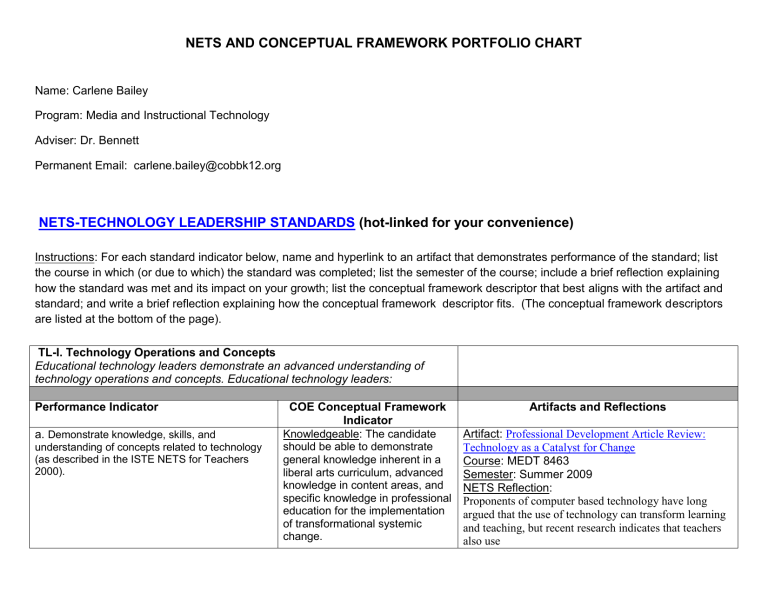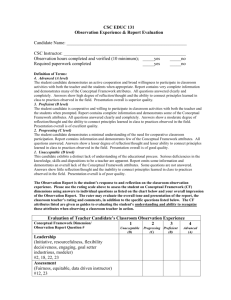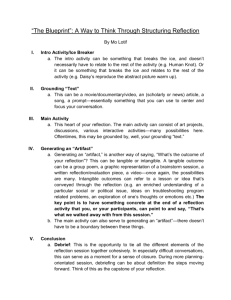NETS AND CONCEPTUAL FRAMEWORK PORTFOLIO CHART
advertisement

NETS AND CONCEPTUAL FRAMEWORK PORTFOLIO CHART Name: Carlene Bailey Program: Media and Instructional Technology Adviser: Dr. Bennett Permanent Email: carlene.bailey@cobbk12.org NETS-TECHNOLOGY LEADERSHIP STANDARDS (hot-linked for your convenience) Instructions: For each standard indicator below, name and hyperlink to an artifact that demonstrates performance of the standard; list the course in which (or due to which) the standard was completed; list the semester of the course; include a brief reflection explaining how the standard was met and its impact on your growth; list the conceptual framework descriptor that best aligns with the artifact and standard; and write a brief reflection explaining how the conceptual framework descriptor fits. (The conceptual framework descriptors are listed at the bottom of the page). TL-I. Technology Operations and Concepts Educational technology leaders demonstrate an advanced understanding of technology operations and concepts. Educational technology leaders: Performance Indicator a. Demonstrate knowledge, skills, and understanding of concepts related to technology (as described in the ISTE NETS for Teachers 2000). COE Conceptual Framework Indicator Knowledgeable: The candidate should be able to demonstrate general knowledge inherent in a liberal arts curriculum, advanced knowledge in content areas, and specific knowledge in professional education for the implementation of transformational systemic change. Artifacts and Reflections Artifact: Professional Development Article Review: Technology as a Catalyst for Change Course: MEDT 8463 Semester: Summer 2009 NETS Reflection: Proponents of computer based technology have long argued that the use of technology can transform learning and teaching, but recent research indicates that teachers also use technology in ways that are consistent with their existing instructional practices. b. Demonstrate continual growth in technology knowledge and skills to stay abreast of current and emerging technologies. Conceptual Framework Reflection: The premise and research involved in writing this paper demonstrates knowledge and understanding of the concepts of technology and how it impacts the learning process and how teachers can best utilize the new technologies to deliver instruction. Any discussion of technology must include consideration of the adaptations that must be made by teachers as they deal with the incorporation of these new skills. Knowledgeable: The candidate Artifact: SAM Progress should be able to demonstrate Course: MEDT 6401 general knowledge inherent in a Semester: Spring 2009 liberal arts curriculum, advanced NETS Reflection: The SAM activity demonstrated knowledge in content areas, and continual growth in technology knowledge and skills specific knowledge in professional to stay abreast of emerging technologies. This education for the implementation assignment may have been easy for many of transformational systemic technologically savvy students, it was challenging change. for me to learn the Microsoft program functions. Conceptual Framework Reflection: Certainly proficiency with Microsoft Office programs demonstrates general knowledge inherent in a liberal arts curriculum. TL-II. Planning and Designing Learning Environments and Experiences Educational technology leaders plan, design, and model effective learning environments and multiple experiences supported by technology. Educational technology leaders: Performance Indicator a. Design developmentally appropriate learning opportunities that apply technologyenhanced instructional strategies to support the diverse needs of learners. b. Apply current research on teaching and learning with technology when planning learning environments and experiences. c. Identify and locate technology resources and evaluate them for accuracy and suitability. COE Conceptual Framework Indicator Culturally Sensitive: The candidate should be able to develop awareness and understanding of individual and group differences when diagnosing and prescribing transformational systemic change. Artifacts and Reflections Artifact: Webquest- The Outsiders Course: MEDT 7467 Semester: Summer 2010 NETS Reflection: This webquest demonstrated developmentally appropriate learning opportunities that apply technology-enhanced instructional strategies that support the diverse needs of learners. Conceptual Framework Reflection: Designing this webquest supported the development of awareness and understanding of group and individual differences used when diagnosing and prescribing transformational systematic change. Proactive: The candidate should Artifact: Literature Review be able to advocate for the Course: MEDT 8484 removal of barriers that impede Semester: Fall 2010 lifelong learning and hinder NETS Reflection: The literature review implemented transformational systemic change. the use of current research on teaching and learning with technology when planning learning environments and experiences. Conceptual Framework Reflection: The literature review focused on advocating for removal of barriers that impede lifelong learning and hinder transformational systematic change. The review focused on the needs of middle school special education students. Knowledgeable: The candidate Artifact: Use of the Smartboard in Education should be able to demonstrate Course: MEDT 8463 general knowledge inherent in a Semester: Summer 2009 liberal arts curriculum, advanced NETS Reflection: Smartboard was evaluated for knowledge in content areas, and effective use in the educational setting. specific knowledge in professional Conceptual Framework Reflection: Knowledge was education for the implementation gained in the use of the Smartboard for educating of transformational systemic d. Plan for the management of technology resources within the context of learning activities. change. 1. Collaborative: The candidate should be able to develop skills to work effectively with various stakeholders involved in the educational process that will bring about transformational systemic change. e. Plan strategies to manage student learning in a technology-enhanced environment. Inquisitive: The candidate should seek continually to improve their knowledge, disposition, and skills to influence transformational systemic change. f. Identify and apply instructional design principles associated with the development of technology resources. Reflective: The candidate should be able to demonstrate critical thinking skills in the diagnosis and prescription for transformational systemic change. middle school students. Artifact: Typewith.me Course: MEDT 7462 Semester: Spring 2010 NETS Reflection:Typewith.me was used with students to allow them to collaborate on a writing assignment using computers. Conceptual Framework Reflection: The program “Typewith.me” was used with students to enable them to work collaboratively on a writing assignment on the computer. Artifact: Use of the Web Cam in an Instructional Setting Course: MEDT 8461 Semester: Spring 2009 NETS Reflection: The assignment involved planning strategies to manage student learning in a technology-enhanced environment. Conceptual Framework Reflection: Learning to use a web cam was new for me. It made me realize that there are many ways educators can use this tool of technology to enhance instruction. Artifact: Curriculum Web Instructional Website Course: MEDT 7467 Semester: Summer 2010 NETS Reflection: This was an all encompassing assignment that brought together many skills and instructional design principles. Many learning strategies were implemented in this project. Conceptual Framework Reflection: The transformational and systemic change occurred in my approach to teaching after completion of this assignment. I now see the web as a tool just as important to teaching as the overhead projector was years ago. TL-III. Teaching, Learning, and the Curriculum Educational technology leaders model, design, and disseminate plans that include methods and strategies for applying technology to maximize student learning. Educational technology leaders: Performance Indicator a. Facilitate technology-enhanced experiences that address content standards and student technology standards. COE Conceptual Framework Indicator Inquisitive: The candidate should seek continually to improve their knowledge, disposition, and skills to influence transformational systemic change. Artifacts and Reflections Artifact: Scavenger Hunt on Computer Course: MEDT 6401 Semester: Spring 2009 NETS Reflection: Students were given websites to explore and find information for a scavenger hunt related to the novel “My Side of the Mountain” Conceptual Framework Reflection: This was the first time I had developed a scavenger hunt on the internet for students, therefore it challenged me to learn new skills to enrich the learning environment using technology. b. Use technology to support learner-centered Adaptive: The candidate should Artifact: Research Project: Technologies for the be able to demonstrate flexibility strategies that address the diverse needs of Middle School Special Needs Students and strategic planning appropriate students. Course: MEDT 8484 to a wide variety of learners for Semester: Fall 2010 effective transformational NETS Reflection: The needs of the special systemic change. education student were addressed in this research project. Learner centered strategies were researched and evaluated as part of this project. Conceptual Framework Reflection: Extensive strategic planning occurred as this project unfolded. c. Apply technology to demonstrate students' higher-order skills and creativity. d. Manage student learning activities in a technology-enhanced environment. e. Use current research and district/state/national content and technology standards to build lessons and units of instruction. The learner centered approach to this research will help to create effective change in the special needs students learning environment. Adaptive: The candidate should Artifact: Use of Inspiration to Create Outsiders Web be able to demonstrate flexibility Course: MEDT 6401 and strategic planning appropriate Semester: Spring 2009 to a wide variety of learners for NETS Reflection: Creativity was used in order to effective transformational design a web reflecting the themes of “The systemic change. Outsiders”. Use of Inspiration. Conceptual Framework Reflection: Flexibility was exhibited by the planning of a web using Inspiration to convey themes in the novel “The Outsiders”. Knowledgeable: The candidate Artifact: Airliner Podcast should be able to demonstrate Course: MEDT 8461 general knowledge inherent in a Semester: Spring 2009 liberal arts curriculum, advanced NETS Reflection: The Airliner was presented as a knowledge in content areas, and tool to enrich the learning environment with specific knowledge in professional technology. education for the implementation Conceptual Framework Reflection: The presentation of transformational systemic of the Airliner Wireless Slate was evidence of change. advanced knowledge in the content area of technology for educational purposes. Knowledgeable: The candidate Artifact: Presentation on the Etherpad, a Web 2.0 should be able to demonstrate tool general knowledge inherent in a Course: MEDT 7462 liberal arts curriculum, advanced Semester: Spring 2010 knowledge in content areas, and NETS Reflection: Technology standards were used specific knowledge in professional to present a lesson on using an EtherPad for education for the implementation instructional purposes. of transformational systemic Conceptual Framework Reflection: Knowledge of change. the use of the EtherPad was required for a presentation. Ideas were presented on how it could be used effectively in an educational setting TL-IV. Assessment and Evaluation Educational technology leaders communicate research on the use of technology to implement effective assessment and evaluation strategies. Educational technology leaders: Performance Indicator a. Apply technology in assessing student learning of subject matter using a variety of assessment techniques. b. Use technology resources to collect and analyze data, interpret results, and communicate findings to improve instructional practice and maximize student learning. COE Conceptual Framework Indicator Adaptive: The candidate should be able to demonstrate flexibility and strategic planning appropriate to a wide variety of learners for effective transformational systemic change. Artifacts and Reflections Artifact: Technology Connected Lesson Plan Course: MEDT 6401 Semester: Spring 2009 NETS Reflection: Use of websites on the internet were used to assess student ability to locate specific information and give correct feedback. Conceptual Framework Reflection: Strategic planning was used in this lesson plan with a group of special education students with a variety of learning differences and preferences. Knowledgeable: The candidate Artifact: Google Docs Survey should be able to demonstrate Course: MEDT 8484 general knowledge inherent in a Semester: Fall 2010 liberal arts curriculum, advanced NETS Reflection: Used Google Docs survey to knowledge in content areas, and collect and analyze data as well as to interpret specific knowledge in professional results education for the implementation Conceptual Framework Reflection: Knowlkedge was of transformational systemic gained in the process of conducting, sorting, and change. analyzing data. Findings used to improve the instructional practice and maximize student c. Apply multiple methods of evaluation to determine students' appropriate use of technology resources for learning, communication, and productivity. Reflective: The candidate should be able to demonstrate critical thinking skills in the diagnosis and prescription for transformational systemic change. TL-V. Productivity and Professional Practice Educational technology leaders design, develop, evaluate and model products created using technology resources to improve and enhance their productivity and professional practice. Educational technology leaders: learning. Artifact: Program and Portfolio Focus Course: MEDT 8463 Semester: Summer 2009 NETS Reflection: Multiple methods of evaluation were used to explore and discover usability of podcasting, blogging, Web 2.0, wiki pages, online evaluation tools and curriculum directed internet exploration. Conceptual Framework Reflection: Critical thinking was used in order to evaluate many different methods of technology and it’s value and use in the educational setting. Performance Indicator a. Use technology resources to engage in ongoing professional development and lifelong learning. COE Conceptual Framework Indicator Leading: The candidate should be able to demonstrate effective leadership skills to initiate and facilitate transformational systemic change. b. Continually evaluate and reflect on professional practice to make informed decisions regarding the use of technology in support of student learning. Inquisitive: The candidate should seek continually to improve their knowledge, disposition, and skills to influence transformational systemic change. c. Apply technology to increase productivity. Collaborative: The candidate should be able to develop skills to work effectively with various stakeholders involved in the educational process that will bring about transformational systemic change. Artifacts and Reflections Artifact: Technology as a Catalyst for Change: The Role of Professional Development Course: MEDT 8463 Semester: Summer 2009 NETS Reflection:The assignment discussed the use of technology resources to engage in on-going professional development and lifelong learning. Conceptual Framework Reflection: This assignment explored technology as a catalyst for change and considered the role of professional development. It’s focus was on the relationship between professional development and teachers’ use of technology. Artifact: Technology Interview Course: MEDT 8461 Semester: Spring 2009 NETS Reflection: This interview that I conducted with our technology specialist included questions about what makes technology successful and how technology affects the learning process. Conceptual Framework Reflection: This interview gave me information needed to improve my knowledge of technology integration in the educational setting. It also increased my understanding of how technology affects the learning process. Artifact: Typewith.me Course: MEDT 7462 Semester: Spring 2010 NETS Reflection:Typewith.me involved the application of technology use to increase student productivity. Conceptual Framework Reflection: This assignment helped to develop skills in order to work effectively with others in the educational setting to bring about transformational systematic change. Typewith.me enabled students to work together and collaborate d. Use technology to communicate and collaborate with peers, parents, and the larger community in order to nurture student learning. on writing projects. Adaptive: The candidate should Artifact: EtherPad PowerPoint be able to demonstrate flexibility Course: MEDT 7462 and strategic planning appropriate Semester: Spring 2010 to a wide variety of learners for NETS Reflection: effective transformational EtherPad is a useful tool for collaborating on a systemic change. document in real time between two or more parties with changes and edits being shown in distinct colors. The tool has a chat feature which allows for communication during the editing process. The PowerPoint was given during the class and the technology has become a part of my daily life since then. The EtherPad I have used can be found at http://typewith.me. Conceptual Framework Reflection: I used this tool to communicate and collaborate with both peers and students. I have used the tool to edit papers with at-home students as well as work with my peers on joint projects. This is one of those delightful tools that really connects people in the process of collaboration and is a valuable asset to any teacher of language arts. TL-VI. Social, Ethical, Legal, and Human Issues Educational technology leaders understand the social, ethical, legal, and human issues surrounding the use of technology in PK-12 schools and develop programs facilitating application of that understanding in practice throughout their district/region/state. Educational technology leaders: Performance Indicator a. Model and teach legal and ethical practice related to technology use. b. Apply technology resources to enable and empower learners with diverse backgrounds, characteristics, and abilities. c. Identify and use technology resources that affirm diversity. COE Conceptual Framework Indicator Proactive: The candidate should be able to advocate for the removal of barriers that impede lifelong learning and hinder transformational systemic change. Artifacts and Reflections Artifact: Copyrights in an Electronic Environment Course: MEDT 6401 Semester: Spring 2009 NETS Reflection: Information was gained relating to the legal and ethical practices related to copyright laws and fair use; Researched rights of the copyright owner and how to avoid copyright trouble. Conceptual Framework Reflection: After exploring and learning laws related to copyright, I am better able to determine how to avoid barriers that may impede lifelong learning and hinder transformational systematic change. Empathetic: The candidate should Artifact: Addressing Diversity be able to develop the sensitivity Course: MEDT 6401 for individual, family, and Semester: Spring 2009 institutional needs that will NETS Reflection: This activity explored an Optical embrace transformational Recognition and Text to Speech resource for the systemic change. visually impaired. Conceptual Framework Reflection: This is a tool of technology that would be used for differentiation in educating the visually impaired student. Culturally Sensitive: The Artifact: Cynthia Says Web Content Assessibility candidate should be able to Report develop awareness and Course: MEDT 7467 understanding of individual and Semester: Summer 2010 group differences when NETS Reflection: This web application allowed me diagnosing and prescribing transformational systemic change. d. Promote safe and healthy use of technology resources. e. Facilitate equitable access to technology resources for all students. to check my website to see if it was user friendly for the students with disabilities Conceptual Framework Reflection: The use of this web application helped to develop awareness and understanding of individuals with disabilities. Artifact: None Available Course: Semester: NETS Reflection: Conceptual Framework Reflection: Proactive: The candidate should Artifact Addressing Diversity with the use of the be able to advocate for the Optical Recognition and Text to Speech resource removal of barriers that impede Course: MEDT 6401 lifelong learning and hinder Semester: Spring 2009 transformational systemic change. NETS Reflection: The use of the Optical Recognition and Text to Speech features would allow the visually impaired equal access to technology. Conceptual Framework Reflection: The use of the Optical Recognition and Text to Speech technology would help to remove the barriers to learning that the visually impaired face in education. TL-VII. Procedures, Policies, Planning, and Budgeting for Technology Environments. Educational technology leaders coordinate development and direct implementation of technology infrastructure procedures, policies, plans, and budgets for PK-12 schools. Educational technology leaders: Performance Indicator COE Conceptual Framework Indicator Inquisitive: The candidate should a. Use the school technology facilities and resources to implement classroom instruction. seek continually to improve their knowledge, disposition, and skills to influence transformational systemic change. b. Follow procedures and guidelines used in planning and purchasing technology resources. Collaborative: The candidate should be able to develop skills to work effectively with various stakeholders involved in the educational process that will bring about transformational systemic change. c. Participate in professional development opportunities related to management of school facilities, technology resources, and purchases. Collaborative: The candidate should be able to develop skills to work effectively with various stakeholders involved in the Artifacts and Reflections Artifact: Use of the Web Cam in the Classroom Course: MEDT 8461 Semester: Spring 2009 NETS Reflection: Technology used was a web cam in order to enhance lesson on how to hold a debate in a language arts classroom Conceptual Framework Reflection: I learned to use a web cam in order to enhance the teaching of how to hold a debate in the classroom. Artifact: iRespond Evaluation Plan Course: MEDT 8480 Semester: Spring 2011 NETS Reflection: Evaluation plan to explore the effectiveness and implementation of the iRespond system as utilized at Hightower Trail Middle School. iRespond was a purchased technology resource implemented to enhance testing and learning by providing an instant response tool for students and teachers. Conceptual Framework Reflection: I became intimately involved and learned much about the purchasing and decision making processes used for purchasing technology in my school system. I also discovered that often such purchases are made without adequate evaluations. Artifact: iRespond Evaluation Plan Course: MEDT 8480 Semester: Spring 2011 NETS Reflection: Part of the iRespond evaluation educational process that will bring about transformational systemic change. plan involved the entire teacher population at my school in staff development to learn how to utilize the new technology. This staff development was evaluated for effectiveness by this evaluation plan. Conceptual Framework Reflection: Participated in professional development opportunities related to the implementation of the iRespond system and evaluated the effectiveness of the tool as well as explored the methods used for purchasing the technology. TL-VIII. Leadership and Vision Educational technology leaders will facilitate development of a shared vision for comprehensive integration of technology and foster an environment and culture conducive to the realization of the vision. Educational technology leaders: Performance Indicator COE Conceptual Framework Indicator Artifacts and Reflections a. Identify and apply educational and technology-related research, the psychology of learning, and instructional design principles in guiding the use of computers and technology in education. b. Apply strategies for and knowledge of issues related to managing the change process in schools. c. Apply effective group process skills. Culturally Sensitive: The candidate should be able to develop awareness and understanding of individual and group differences when diagnosing and prescribing transformational systemic change. Artifact: Ethological Theories Course: CEP 8102 Semester: Spring 2010 NETS Reflection: technology was used to research the psychology of learning. The principle of “ontogeny recapitulates phylogeny” was reviewed to interpret how it has an impact on human behavior and education. Conceptual Framework Reflection: Exploration of the psychology of learning was conducted using the computer and internet. My understanding of individual differences in the learning environment was enhanced. Empathetic: The candidate should Artifact: Stakeholder’s Interview be able to develop the sensitivity Course: MEDT 8461 for individual, family, and Semester: Spring 2009 institutional needs that will NETS Reflection: An interview with a parent of a embrace transformational student was conducted to gain feedback on how the systemic change changes in technology are affecting the education of her child. Conceptual Framework Reflection: My sensitivity to individual student and family needs were enhanced after interviewing a parent about the changes in technology in the school system where I am employed. Leading: The candidate should be Artifact: The Outsiders Group Response Activity able to demonstrate effective Course: MEDT 7467 leadership skills to initiate and Semester: Summer 2010 facilitate transformational NETS Reflection: This activity is from a website systemic change. created to teach The Outsiders to a group of middle school students. It applies effective group process skills through the use of careful instructions and a Google Doc response form to be completed by group participants. Conceptual Framework Reflection: Leading a group of young learners requires flexibility and clear instructions. Participating in effective group activities will facilitate systemic changes in the learning d. Lead in the development and evaluation of district technology planning and implementation. e. Engage in supervised field-based experiences with accomplished technology facilitators and/or directors. dynamics of my small group. This activity in particular was very effective at motivating learning. Adaptive: The candidate should Artifact: iRespond Evaluation Final Report be able to demonstrate flexibility Course: MEDT 8480 and strategic planning appropriate Semester: Spring 2011 to a wide variety of learners for NETS Reflection: This report reflects the results of effective transformational the iRespond system implementation and tool systemic change. effectiveness as utilized at Hightower Trail Middle School. Conceptual Framework Reflection: The information in this report will help guide future efforts in the development and acquisitions of district technology implementations. Collaborative: The candidate Artifact: Technology Interview/Power Point should be able to develop skills to Presentation work effectively with various Course: MEDT 8461 stakeholders involved in the Semester: Spring 2009 educational process that will bring NETS Reflection: An extensive interview was about transformational systemic conducted with a technology specialist in Cobb change. County. Information was gathered on shat has been successful in the diffusion of technology into education and how technology affects the learning process. Conceptual Framework Reflection: Ideas were gathered from a specialist in the field of technology on how to effectively remove barriers that impede lifelong learning and the integration of technology into the classroom II. COE CONCEPTUAL FRAMEWORK Conceptual Framework Descriptors 2. Decisive: The candidate should be able to demonstrate knowledge and skills when making decisions that will influence effective transformational systemic change. 3. Leading: The candidate should be able to demonstrate effective leadership skills to initiate and facilitate transformational systemic change. 4. Inquisitive: The candidate should seek continually to improve their knowledge, disposition, and skills to influence transformational systemic change. 5. Adaptive: The candidate should be able to demonstrate flexibility and strategic planning appropriate to a wide variety of learners for effective transformational systemic change. 6. Collaborative: The candidate should be able to develop skills to work effectively with various stakeholders involved in the educational process that will bring about transformational systemic change. 7. Culturally Sensitive: The candidate should be able to develop awareness and understanding of individual and group differences when diagnosing and prescribing transformational systemic change. 8. Empathetic: The candidate should be able to develop the sensitivity for individual, family, and institutional needs that will embrace transformational systemic change. 9. Knowledgeable: The candidate should be able to demonstrate general knowledge inherent in a liberal arts curriculum, advanced knowledge in content areas, and specific knowledge in professional education for the implementation of transformational systemic change. 10. Proactive: The candidate should be able to advocate for the removal of barriers that impede lifelong learning and hinder transformational systemic change. 11. Reflective: The candidate should be able to demonstrate critical thinking skills in the diagnosis and prescription for transformational systemic change.








